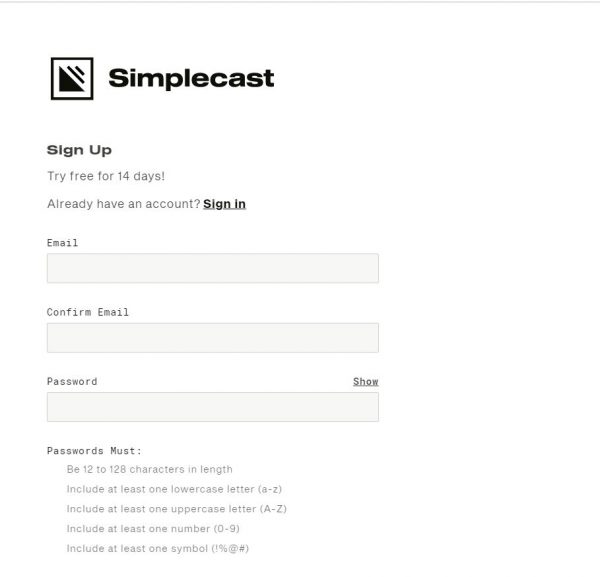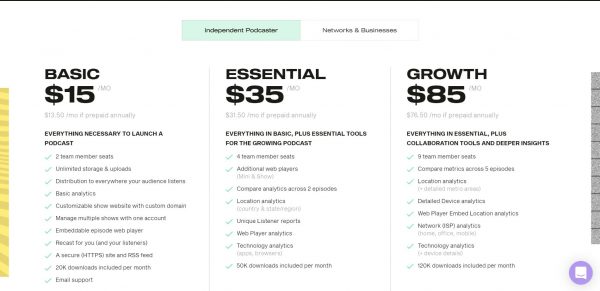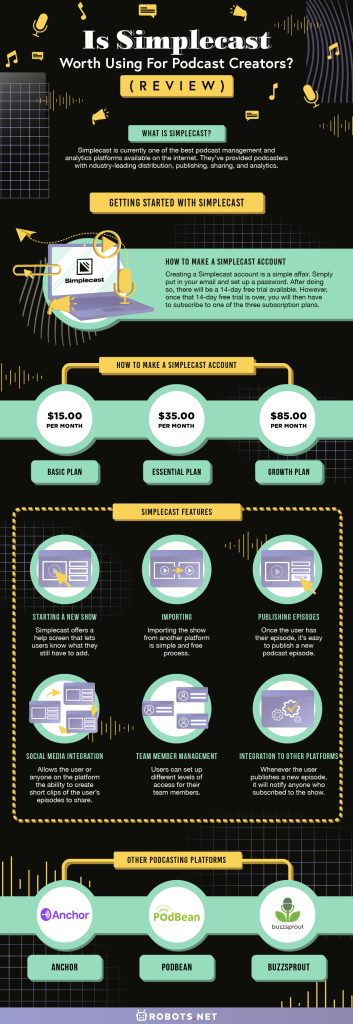Podcasts are a great form of entertainment. However, creating and hosting them is hard if you don’t know where to start. Luckily, there is a way for you to not only create your podcasts but also host them. And that’s through Simplecast.
What Is Simplecast?


Before you start your podcast, there are two important things you have to consider when choosing the right platform: how long it has been in business and whether they’ll still be around in the foreseeable future. And Simplecast has the right answers to these questions.
Simplecast is currently one of the best podcast management and analytics platforms available on the internet. Powering podcasts from well-known creators and brands like Dax Shepard, Politico, and Facebook, just to name a few, the service delivers almost a billion audio streams every year. Even if you’re just starting in the field, Simplecast gives you access to similar tools used by the big names out there.
Simplecast has been here since 2013, meaning they’re an established institution in the podcast space. For seven years, they’ve provided podcasters with industry-leading distribution, publishing, sharing, and analytics. Many similar services have come and gone, and they’re still here. So, it’s a fair thing to state that they’re considered to be a safe home for people to podcast.
If you’re looking to try out other platforms, we have review articles for Anchor and Podbean.
Getting Started With Simplecast


How to Make a Simplecast Account
Creating a Simplecast account is a simple affair. Simply put in your email and set up a password. After doing so, there will be a 14-day free trial available. However, once that 14-day free trial is over, you will then have to subscribe to one of the three subscription plans.
Subscription Plans


Simplecast has three subscription plans that users can subscribe to. They have the Basic Plan that costs $15 a month ($13.50/month if paid annually), the Essential Plan that costs $35 a month ($31.50/month if paid annually), and lastly, the Growth Plan at $85 a month ($76.50/month if paid annually).
There are several similarities and differences between the three subscription plans that you have to take into account. Simplecast offers users unlimited storage space and uploads, various listener analytics and reports, the ability to share clips on social media, and a great, customizable themed website when you subscribe to any of their plans.
They did add in a soft limit on the amount of total monthly downloads that your podcast can receive, depending on what subscription tier you’re currently on. The limit is 20,000 for the Basic plan. Essential plan subscribers can get up to 50,000. And lastly, the Growth subscription tier can go up to 125,000.
If you hit your monthly limit, Simplecast will give you the option to upgrade. Don’t worry; Simplecast will not cut you off or upgrade your account without your express permission.
Moreover, with the Essential and Growth tiers, you can add additional team members to your Simplecast account, gain access to more web players, color customization, and advanced insights on the podcast’s audience.
As for the payment methods that Simplecasts accepts, you have the option to use a Visa or Mastercard.
Simplecast Features
Starting a New Show
When the user is starting a new show, Simplecast will first walk the user through the basic details that they’ll need to get set up, like the title & description, artwork, format (episodic, serial, et cetera), time zone, language, explicit content, category selection, and owner details. Most settings, like the artwork and categories, for example, can be forgone and fiddled with later.
Once the user gets to the dashboard, Simplecast offers a help screen that lets users know what they still have to add, and additional links to more resources that they can use.
Importing
If the user’s importing their show from another platform, it’s a simple and free process. The only thing they need is the show’s current RSS Feed URL. Said import will create a copy of the current show, but won’t change the current host setup. Here’s how you can do this:
- Log into your Simplecast account or make a new one.
- Click on “Import a Podcast.”
- Copy and paste your podcast RSS feed URL into the field indicated and click on the Validate RSS Feed icon.
- After the Podcast RSS feed URL is validated, the Import button will show up. Click on it to proceed.
Simplecast will now create a copy of the existing show into the user’s new account. The user will see the name of the show located on the top-left side of the show’s dashboard with a message that the episodes of the podcasts are now being imported. - Go to the user’s Podcast Settings page and ensure that the information about the show being imported is correct, and make edits on the info before continuing.
Publishing Episodes
Once the user has their episode notes and audio file ready and waiting, it’s an easy thing for them to publish a new podcast episode on Simplecast. Here’s how:
- Select the New Episode button located on the top right of the user dashboard.
- Add in/edit the Episode Page Layout.
- Episode Details: The left side is where the user uploads the audio file as well as type in other required details about the episode.
- Preview: The right side of the page is where the user is given a live preview of the episode to show them what they still need to add.
- Once the user finishes putting what they need to add, simply press Save Draft.
- Once the user is satisfied with the draft, they can choose to either schedule the episode, or publish the episode now.
Social Media Integration
Simplecast has a public social sharing feature called Recast. This allows the user or anyone on the platform the ability to create short clips of the user’s episodes to share with other people.
Team Member Management
Users can also set up different levels of access for their team members. This is a great future as it gives prioritization of roles and responsibilities.
Integration to Other Platforms
How to Distribute Your Show
Getting a user’s podcast into other popular podcast directories and applications is a pretty easy and free endeavor. Here’s how:
- Set up and create your podcast on Simplecast.
- Have at least one episode already out.
- Paste in the show’s RSS feed URL to the podcast directories of the user’s choice.
- Get approved and listed in all the directories you chose from.
How It Works
The podcast directories and apps on Simplecast monitors the RSS feed that Simplecast gives, as well as any updates on the user’s show after they submit the show’s RSS feed URL to those directories.
Whenever the user publishes a new episode on their Simplecast account, the directory or app that the show is on will see that there’s a new episode published, and will immediately download, display, and notify anyone who subscribed to the show that a new episode is currently available for either streaming or download.
Do note, however, that before a user submits their show’s feed URL for an app or directory’s review and approval, the user should have supplied all needed information about the podcast on Simplecast’s Show Settings page. There should also be at least one published episode for the show.
Simplecast vs Other Podcasting Platforms
Other than Simplecast, other Podcast Publishing platforms might tickle your fancy. Here are a few competitors that you may consider:
Anchor


Perhaps the best thing about Anchor is that it’s free. However, it can’t devote too much of the resources that it has into organizing and parsing podcast listener data for the user to use.
With Anchor, users will be able to take a look at their overall plays by date and the number of downloads that an episode has, but not a lot else. When compared to Simplecast? That’s merely a shallow thing as Simplecast gives a deeper insight into how their podcast is performing and what audiences are listening to, and a whole lot more.
Podbean


Podbean is similar enough to Simplecast as it offers the user all the basic things that they need to start and promote their podcast. Also, like Simplecast, Podbean has been around the block for a long time now. It’s a trusted brand by more than 360,000 podcasters, as well as some well-known brands like Stripe, IBM, and J.P Morgan to name a few.
As for the differences between the two? Well, there are a few key differences.
In terms of functionality, Podbean gives users a lot of powerful podcasting tools that Simplecast can’t offer. For example, it allows users to do Video Podcasting, as well as Live Audio Streaming. And when the user does live audio streaming, they can not only take listener calls and get real-time comments for their podcasts, but they can also get virtual currency from various ticket sales and gifts. Also, Podbean has an app audio recorder that makes it easy for users to record, edit, and publish podcasts from the user’s phone.
However, Simplecast has its advantages as well. Simplecast has a better and more robust podcast analytics platform that gives users more insight and data on their podcasts compared with Podbean. It also has a podcast sharing/discovery tool on its service called Recast that allows users and their listeners to share and post custom clips of their episodes to social media.
Overall, they’re pretty similar, but if you’re looking for better analytics, best use Simplecast. If you’re going for better options when it comes to streaming, go for Podbean.
Buzzsprout


Both Buzzsprout and Simplecast offers their users features like a customizable player, podcast statistics, and a custom podcast website, in addition to a dashboard that’s easy to use.
With all these similarities, are there any key differences between the two platforms? The answer to that is yes.
Firstly, Buzzsprout gives users a free podcast hosting plan where they have to upload at least two hours of content every month for up to three months. Meanwhile, Simplecast gives users a free 14-day trial. However, if the user’s serious about podcasting, then it doesn’t matter what free hosting plans or trials the sites give them. What matters is the features.
Simplecast gives users unlimited audio for all the paid plans they have. Meanwhile, Buzzsprout has a fixed monthly limit on the audio content that users publish and they have to pay an extra fee if they wish to upload more audio content.
Also, Simplecast allows users to host multiple podcast shows and have multiple team members on their profile. Meanwhile, Buzzsprout only allows the user to have multiple team members.
Thus, when it comes to functionality, Simplecast, is the better of the two platforms, as it doesn’t give limits to how many audio files you can add in, and doesn’t charge you for putting them in the first place.
























